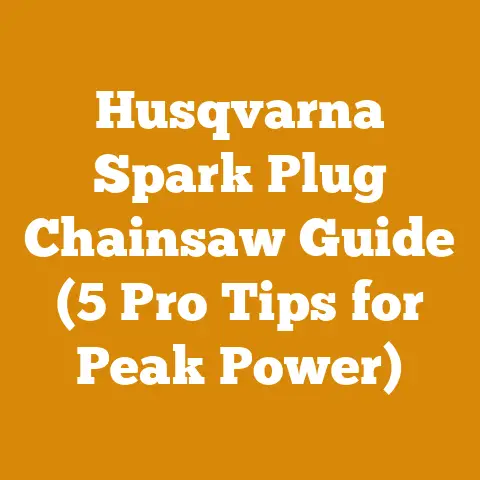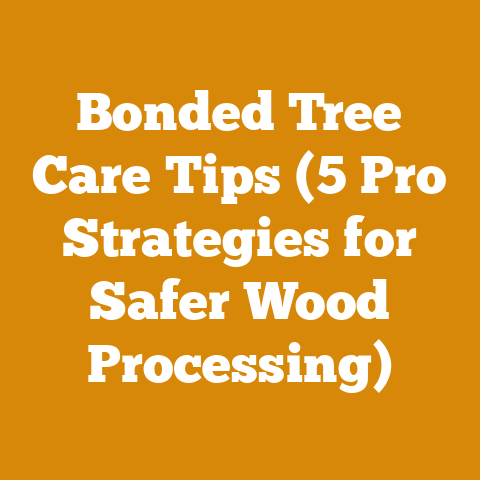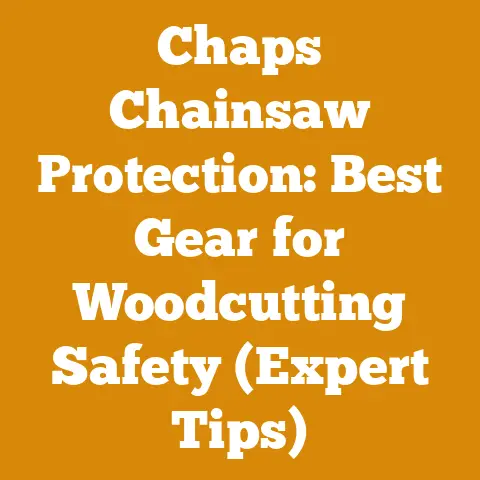Circular Saw Blade for Weedeater (5 Pro Tips for Arborists)
Ever thought about turning your weed eater into a mini lumberjack? The idea of slapping a circular saw blade onto your trusty weed whacker might sound like a DIY dream come true, a shortcut to clearing brush and small trees with the agility of a hummingbird. But hold on a minute, my friends. Before you go full-throttle on this project, let’s dive deep into the realities, risks, and rewards of using a circular saw blade on a weed eater.
Circular Saw Blade for Weedeater: 5 Pro Tips for Arborists
This isn’t just about slapping on a blade and hoping for the best. This is about safety, efficiency, and understanding the nuances that separate a successful brush-clearing operation from a potential disaster. I’ve spent years in the woods, from felling trees with my grandfather’s antique axe to managing complex logging operations, and I’ve learned that respecting the tools and understanding their limitations is paramount.
1. Is It Even Safe? The Reality Check
Let’s start with the elephant in the room: safety. Using a circular saw blade on a weed eater is inherently riskier than using the standard nylon string or even a brush blade designed for the purpose. Why? Because weed eaters aren’t designed to handle the torque and forces generated by a circular saw blade biting into wood.
- Kickback: This is the biggest danger. A circular saw blade can grab and kick back violently, especially if it encounters a knot or hard spot in the wood. Weed eaters lack the safety features (like chain brakes) found on chainsaws to mitigate this risk.
- Blade Shatter: Cheap or improperly installed blades can shatter under stress, sending potentially lethal fragments flying.
- Lack of Control: Weed eaters are designed for light trimming, not heavy cutting. The lightweight construction and lack of proper handles make it difficult to control the tool when using a circular saw blade.
- Gearbox Overload: The gearbox of your weed eater might not be designed to handle the increased load of a circular saw blade. This can lead to premature failure or even a catastrophic breakdown.
Data Point: According to the U.S. Consumer Product Safety Commission (CPSC), injuries involving lawn and garden equipment, including weed eaters, result in tens of thousands of emergency room visits each year. While specific data on circular saw blade modifications is scarce, the general trend highlights the potential for serious injury.
Personal Story: I once witnessed a friend try a similar modification. He used a metal blade (not a circular saw blade, but still a hardened metal blade) on his weed eater to try and clear some thick brush. The blade hit a rock, shattered, and a piece of it grazed his leg. Luckily, it wasn’t a deep cut, but it was a stark reminder of the dangers involved.
Pro Tip: If you’re considering this modification, ask yourself honestly if you’re prepared to accept the increased risk. Are you willing to invest in proper safety gear (face shield, chaps, gloves)? Are you experienced enough to handle the potential kickback? If the answer to either of those questions is no, reconsider your approach.
2. Blade Selection: Choosing the Right Tool for the Job
Okay, let’s say you’ve weighed the risks and are still determined to proceed. The next crucial step is selecting the right blade. Not all circular saw blades are created equal, and using the wrong one can exacerbate the dangers.
- Diameter: Choose a blade diameter that is appropriate for your weed eater’s cutting head. A blade that is too large will put excessive strain on the motor and gearbox.
- Arbor Size: Ensure the blade’s arbor (center hole) size matches your weed eater’s spindle. Using an adapter can introduce vibration and increase the risk of blade failure.
- Tooth Count and Design: For cutting brush and small trees, a blade with fewer, larger teeth is generally better than a blade with many small teeth. Blades designed for wood cutting are preferable to those designed for metal. Look for blades specifically marketed for brush cutting or clearing.
- Material: Opt for high-quality steel blades from reputable manufacturers. Avoid cheap, imported blades that may be prone to shattering. Carbide-tipped blades offer increased durability and cutting performance, but they are also more expensive.
Data Point: A study by the Forest Products Laboratory found that blade material and tooth geometry significantly impact cutting efficiency and blade life. Investing in a higher-quality blade can save you money in the long run by reducing downtime and replacement costs.
Personal Story: I once tried to save a few bucks by buying a cheap blade online. It lasted about 15 minutes before the teeth started chipping and the blade began to wobble.
Pro Tip: Do your research. Read reviews, compare specifications, and talk to experienced arborists or landscapers before making a purchase. Don’t be afraid to spend a little extra money on a blade that is known for its durability and safety.
3. Installation and Maintenance: The Devil Is in the Details
Proper installation and maintenance are critical for safe and efficient operation. A poorly installed or maintained blade is a recipe for disaster.
- Follow the Manufacturer’s Instructions: Always refer to the weed eater and blade manufacturer’s instructions for proper installation procedures.
- Secure the Blade Tightly: Ensure the blade is securely fastened to the spindle. Use the correct hardware and tighten it to the specified torque.
- Inspect the Blade Regularly: Before each use, inspect the blade for cracks, chips, or other damage. Replace the blade immediately if any damage is found.
- Sharpen the Blade: A dull blade is more likely to bind and kick back. Sharpen the blade regularly using a file or grinding wheel.
- Lubricate Moving Parts: Keep the weed eater’s gearbox and cutting head lubricated according to the manufacturer’s recommendations.
Data Point: A study by the National Institute for Occupational Safety and Health (NIOSH) found that improper tool maintenance is a significant contributing factor to workplace injuries.
Personal Story: I once neglected to properly tighten the blade on my brush cutter. After a few minutes of use, the blade started to vibrate violently. I immediately shut down the machine and discovered that the blade was about to come loose. A little diligence saved me from a potentially serious accident.
Pro Tip: Invest in a good quality blade sharpening kit. Learning to properly sharpen your blades will not only improve their performance but also extend their lifespan, saving you money in the long run.
4. Technique and Environment: Mastering the Art of the Cut
Even with the right blade and proper installation, your cutting technique and the environment in which you’re working play a crucial role in safety and efficiency.
- Clear the Area: Before starting, clear the area of any obstacles, such as rocks, branches, or debris.
- Use Proper Stance: Maintain a stable stance and keep your feet firmly planted on the ground.
- Cut at the Correct Angle: Cut at a shallow angle to avoid binding and kickback.
- Avoid Cutting Near the Ground: Avoid cutting near the ground to prevent the blade from hitting rocks or other objects.
- Be Aware of Your Surroundings: Pay attention to your surroundings and be aware of any potential hazards, such as power lines or pedestrians.
- Consider the Wood: Different wood types react differently to cutting. Softer woods like pine are easier to cut than hardwoods like oak. Be aware of the wood type you’re cutting and adjust your technique accordingly.
Data Point: Studies on forestry worker safety consistently highlight the importance of proper technique and situational awareness in preventing accidents.
Personal Story: I was once clearing brush in a heavily wooded area when I accidentally cut through a hidden underground cable. Fortunately, I wasn’t injured, but it was a close call. Now, I always call before I dig or cut in unfamiliar areas.
Pro Tip: Practice in a safe, controlled environment before tackling more challenging projects. Start with small, manageable tasks and gradually increase the difficulty as your skills improve.
5. Alternatives and Considerations: Exploring Other Options
Before you commit to using a circular saw blade on your weed eater, consider the alternatives. There are often safer and more efficient ways to achieve your desired results.
- Brush Cutters: Brush cutters are specifically designed for clearing brush and small trees. They are more powerful and have safety features that weed eaters lack.
- Chainsaws: Chainsaws are the go-to tool for cutting trees and large branches. They are more efficient and safer than using a circular saw blade on a weed eater for anything beyond very small saplings.
- Loppers and Pruners: For smaller branches and shrubs, loppers and pruners are a safer and more precise option.
- Professional Services: If you have a large or complex project, consider hiring a professional arborist or landscaping company.
Cost Considerations:
Let’s talk about the financial aspect. While the initial cost of slapping a blade on your weed eater might seem appealing, consider the long-term costs:
- Blade Replacement: Cheap blades wear out quickly and need frequent replacement. High-quality blades are more expensive but last longer.
- Weed Eater Repair: Overloading your weed eater with a circular saw blade can lead to premature wear and tear, resulting in costly repairs.
- Safety Gear: Investing in proper safety gear (face shield, chaps, gloves) is essential.
- Potential Medical Bills: In the event of an accident, medical bills can quickly add up.
Data Point: According to the Equipment Dealers Association, the average repair cost for a lawn and garden equipment is around $150. However, repairs resulting from misuse or modification can be significantly higher.
Personal Story: I once tried to save money by doing some tree work myself instead of hiring a professional. I ended up damaging my chainsaw and injuring my back. In the end, it cost me more money (and pain) than it would have to hire a professional in the first place.
Pro Tip: Before starting any project, create a detailed budget that includes all potential costs. Compare the cost of doing it yourself with the cost of hiring a professional. You might be surprised to find that hiring a professional is actually more cost-effective in the long run.
Final Thoughts:
Using a circular saw blade on a weed eater can be a tempting shortcut for clearing brush and small trees. However, it’s important to weigh the risks and consider the alternatives. If you choose to proceed, do so with caution, using the right blade, proper installation, and safe techniques. Remember, safety should always be your top priority.
Actionable Takeaways:
- Assess the Risks: Honestly evaluate your skills and the potential dangers before attempting this modification.
- Choose the Right Blade: Invest in a high-quality blade designed for brush cutting.
- Follow the Instructions: Carefully follow the manufacturer’s instructions for installation and maintenance.
- Practice Safe Techniques: Use proper stance, cutting angles, and situational awareness.
- Consider Alternatives: Explore safer and more efficient options, such as brush cutters or chainsaws.
- Create a Budget: Factor in all potential costs, including blade replacement, weed eater repair, and safety gear.
Ultimately, the decision is yours. But by understanding the risks, rewards, and alternatives, you can make an informed choice that will help you achieve your goals safely and efficiently. Remember, a little planning and preparation can go a long way in the world of wood processing and brush clearing. So, stay safe, work smart, and happy cutting!






